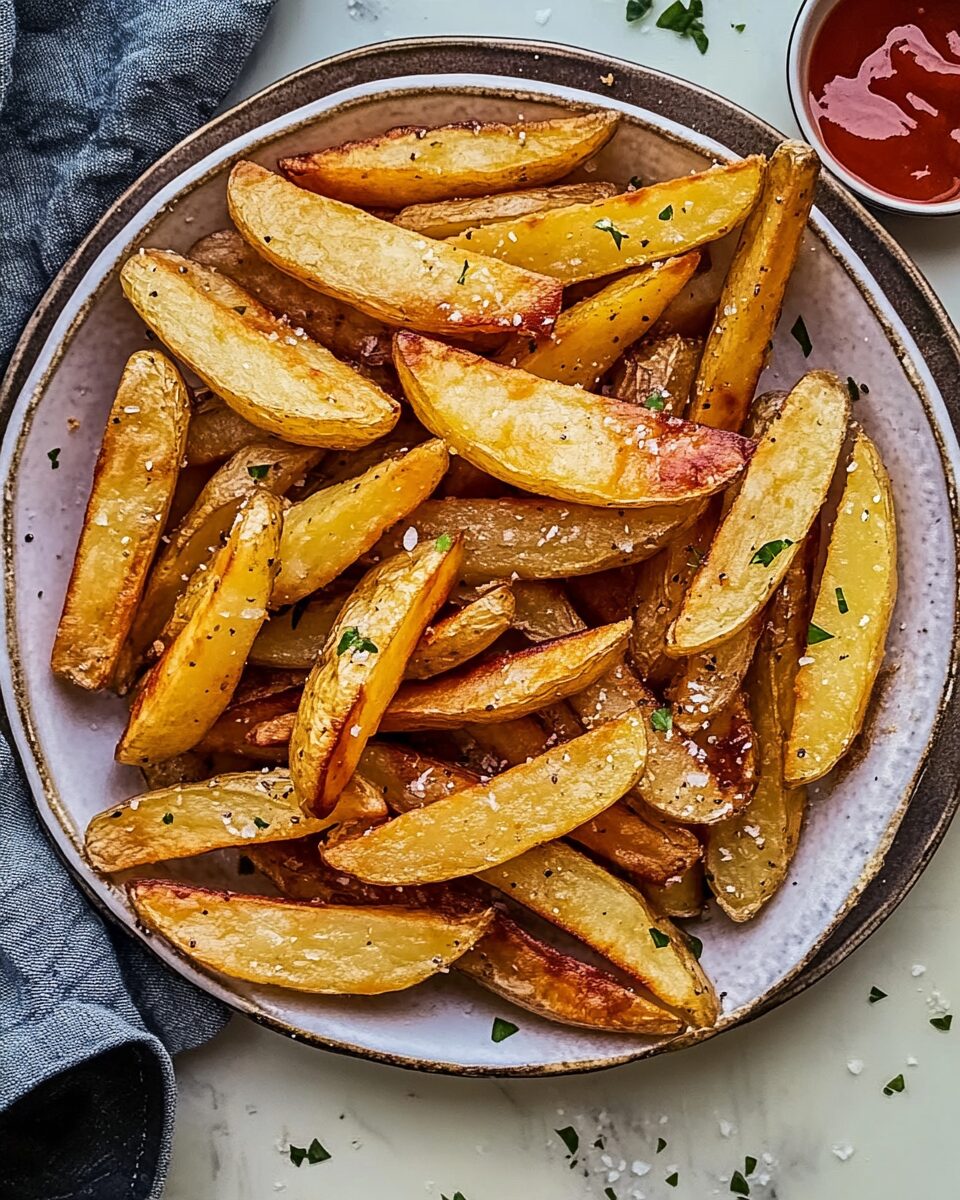French Fried Potatoes, commonly known as French fries, are the ultimate comfort food, crispy on the outside and tender on the inside. These fries are perfect for any occasion, whether you’re hosting a casual get-together, preparing a side dish for burgers, or simply indulging in a favorite snack.
This classic French fry recipe uses just a few simple ingredients to create a crispy, golden result that will have everyone reaching for seconds. Serve them with your favorite dipping sauces or as a side to a main course, and watch them disappear in no time. The key to perfectly fried potatoes is achieving the right temperature of the oil and frying in small batches for even crispiness.
Full Recipe:
- 4 large potatoes, peeled and cut into fries
- 1 cup vegetable oil, for frying
- Salt, to taste
- Optional: seasoning of choice (garlic powder, paprika, or herbs)
Directions:
- Peel and slice potatoes into thin strips.
- Heat the vegetable oil in a deep pan over medium heat until it reaches 350°F (175°C).
- Fry the potato strips in batches for 3-4 minutes, or until golden and crispy.
- Remove fries from oil and place on paper towels to drain excess oil.
- Season with salt and any other desired seasoning while still hot.
Prep Time: 15 minutes | Cooking Time: 20 minutes | Total Time: 35 minutes
Kcal: 365 kcal | Servings: 4 servings
The Art and Science of Making Perfect French Fries
French fries are one of the world’s most popular foods, loved by people of all ages and enjoyed in almost every corner of the globe. From fast-food chains to gourmet restaurants, the humble French fry transcends borders, cultures, and culinary traditions. But what makes the perfect French fry? Let’s explore the secrets behind crafting crispy, golden French fries that can rival any restaurant-quality dish.
A Brief History of French Fries
Despite their name, French fries may not have originated in France. The debate over the origin of French fries involves both the French and the Belgians, with both countries claiming to have invented them. The Belgian theory suggests that villagers along the River Meuse, as early as the 17th century, would fry small fish, but when the river froze in winter, they turned to frying potatoes instead. On the other hand, some historical references indicate that French fries were popularized in France, where street vendors sold them as early as the late 18th century.
The term “French fries” was popularized in the United States during World War I when American soldiers in Belgium encountered the dish and referred to it as “French” because French was the dominant language of the Belgian army. Since then, French fries have become a staple in American cuisine and around the world, often served alongside burgers, sandwiches, and grilled meats.
The Essential Elements for Crispy French Fries
Making the perfect French fries at home requires attention to a few key factors that ensure you get that irresistible crunch while keeping the inside tender and fluffy. Here are the essential elements:
- Choosing the Right Potato: Not all potatoes are created equal when it comes to making fries. The best type of potato for frying is starchy varieties, such as Russet or Idaho potatoes. These potatoes are low in moisture and high in starch, which helps achieve the perfect crispy texture.
- Proper Frying Temperature: The key to crispy fries is frying them at the right temperature. The ideal temperature for frying French fries is 350°F (175°C). If the oil is too hot, the fries will brown too quickly on the outside without cooking through. If it’s too low, the fries will absorb too much oil and become greasy.
- Double Frying Method: One of the best secrets to restaurant-quality French fries is double frying. The first fry is done at a lower temperature (around 300°F), cooking the potatoes without adding too much color. After draining and letting them cool, the second fry at a higher temperature crisps up the exterior and gives the fries their golden-brown color.
- Draining Excess Oil: After frying, it’s crucial to drain the fries on paper towels or a wire rack to remove excess oil. This helps maintain their crispiness and prevents sogginess.
- Seasoning at the Right Time: Season your fries immediately after frying, while they are still hot. This allows the salt and seasonings to stick to the surface, enhancing the flavor of the fries.
Creative Ways to Customize French Fries
While the classic French fry recipe calls for simple seasoning with salt, there are countless ways to add your own twist to this versatile snack. Below are some popular variations you can experiment with:
- Garlic Parmesan Fries: After frying, toss the hot fries with grated Parmesan cheese, minced garlic, and a sprinkle of parsley. The result is a rich, savory fry with a burst of garlic flavor.
- Cajun-Spiced Fries: For a kick of heat, season your fries with a mix of Cajun spices such as paprika, cayenne pepper, garlic powder, and black pepper. These fries are perfect for adding a little spice to your meal.
- Truffle Fries: Drizzle the freshly fried fries with truffle oil and sprinkle with sea salt and grated Parmesan. This gourmet twist on French fries is often found in upscale restaurants and can be paired with a variety of sauces.
- Sweet Potato Fries: For a healthier alternative, swap out regular potatoes for sweet potatoes. Sweet potato fries offer a naturally sweet flavor and pair well with cinnamon, brown sugar, or a hint of chili powder.
- Loaded Fries: Loaded fries are a fun way to turn your fries into a meal. Top your fries with melted cheese, bacon bits, green onions, sour cream, and even chili for a dish that’s hearty and satisfying.
Dipping Sauces to Elevate Your Fries
While ketchup is the classic companion for French fries, there are many other dipping sauces that can elevate your fry-eating experience. Here are some delicious options to consider:
- Garlic Aioli: A creamy garlic aioli is a sophisticated alternative to regular mayonnaise, offering a bold and tangy flavor that complements crispy fries perfectly.
- Sriracha Mayo: For those who like it spicy, a blend of mayonnaise and sriracha sauce adds a creamy heat to each bite.
- Cheese Sauce: A rich, warm cheese sauce is a decadent option, especially when paired with fries that have been sprinkled with bacon or herbs.
- Ranch Dressing: Cool and creamy ranch dressing is a favorite for dipping fries, especially in the United States.
- Honey Mustard: The sweet and tangy flavor of honey mustard provides a delightful contrast to the salty fries, making it a fun alternative to ketchup.
Fun Facts About French Fries
- National French Fry Day: French fries are so beloved that they have their own holiday. National French Fry Day is celebrated every year on July 13th in the United States, where people indulge in their favorite fry varieties.
- The World’s Longest Fry: According to the Guinness World Records, the longest French fry ever made measured 34 inches (86 cm). It was created by Twin Oaks Farms in Maine in 2018.
- French Fries in Space: In 1995, NASA and the University of Wisconsin experimented with growing potatoes in space. While this didn’t lead to space fries just yet, it’s exciting to think that future astronauts could one day enjoy fries in zero gravity.
- Fries Around the World: Different countries have their own take on French fries. In Belgium, they are served with mayonnaise. In Canada, poutine (fries topped with cheese curds and gravy) is a national dish. In the Netherlands, Dutch fries are served with a combination of mayonnaise and ketchup called “fritessaus.”
The Healthier Side of French Fries
Although French fries are often considered a guilty pleasure, there are ways to make them a bit healthier without sacrificing flavor. Here are some tips for enjoying fries without overindulging:
- Air Fryer Fries: The air fryer has become a popular tool for making crispy fries with little to no oil. By using hot air circulation, the air fryer creates fries that are golden and crunchy on the outside but lower in fat.
- Baked Fries: Baking fries in the oven is another healthier alternative to deep frying. Toss the potatoes with a small amount of olive oil and bake at a high temperature to achieve a crispy texture.
- Portion Control: As with any indulgent food, portion control is key. Pair your fries with a balanced meal that includes vegetables, lean proteins, and whole grains to enjoy them as part of a nutritious diet.
Conclusion
French fries are more than just a side dish; they are a global comfort food that can be enjoyed in countless ways. Whether you prefer classic fries with a sprinkle of salt, loaded fries topped with all the fixings, or a healthier baked version, there is a type of French fry for everyone. Their versatility allows them to be a canvas for a variety of flavors, from spicy to savory, and their pairing with sauces opens up endless possibilities.
For home cooks, making French fries from scratch is a rewarding experience that allows for creativity and personalization. By selecting the right type of potato, mastering frying techniques, and experimenting with seasonings and dips, you can elevate your French fry game and impress family and friends with your cooking skills.
Ultimately, whether served at a casual family dinner, a backyard barbecue, or a fancy gourmet meal, French fries continue to be a universally loved treat that brings joy and satisfaction to every bite.






